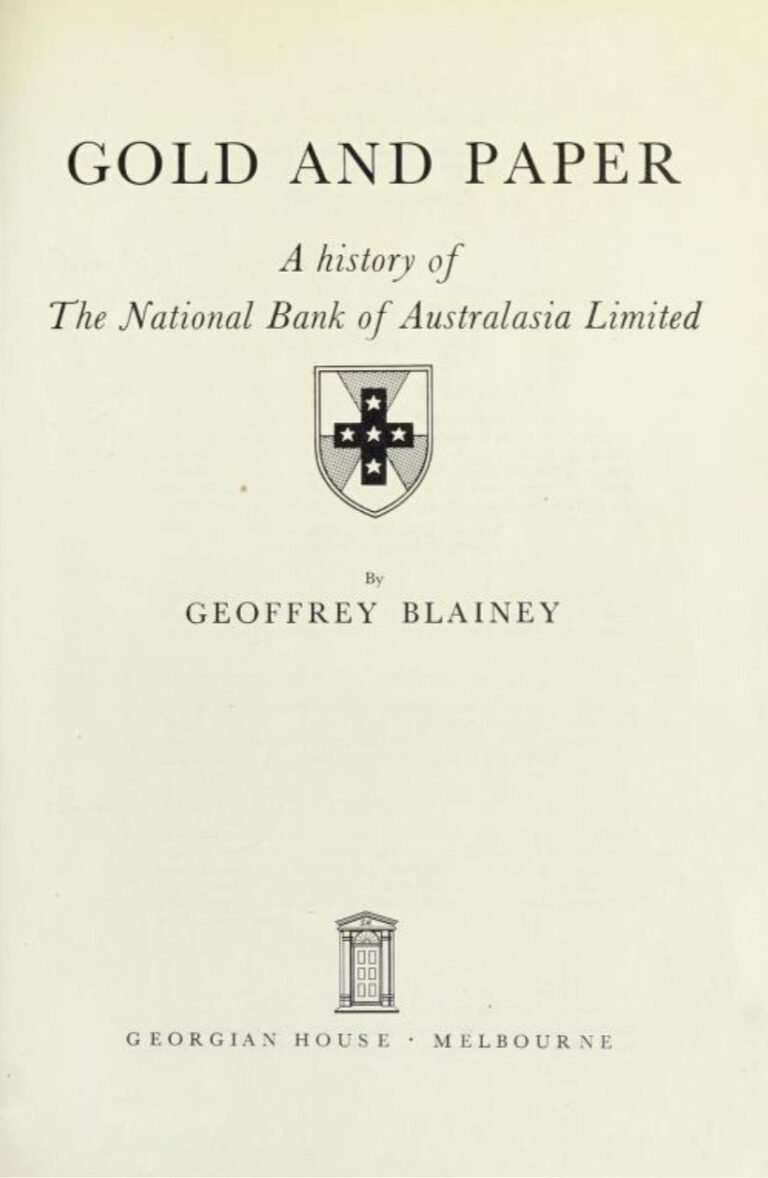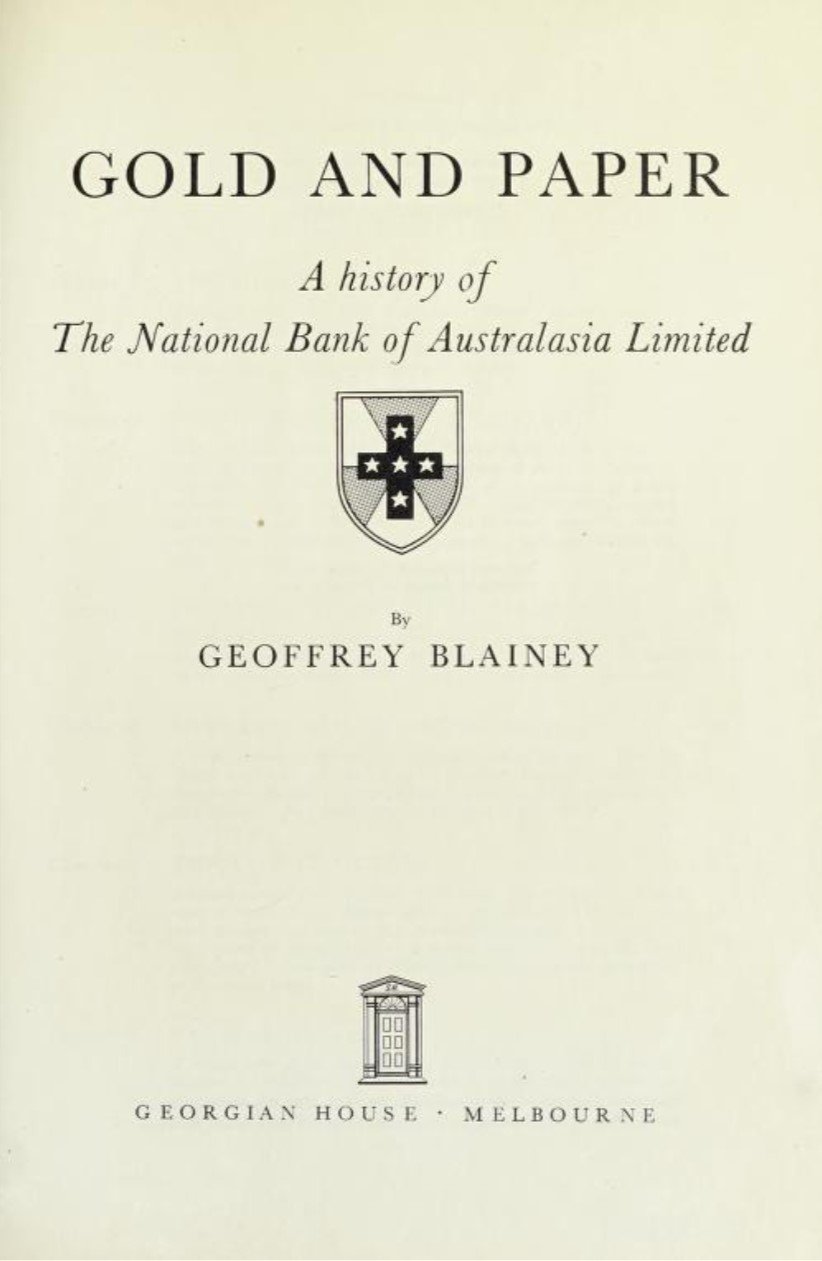Geoffrey Blainey, Gold and Paper: A History of the National Bank of Australasia Ltd. (1958)
Geoffrey Blainey is arguably Australia’s greatest living historian, and one of just two authors appearing in the Menzies Collection who has had direct involvement with the Robert Menzies Institute.
Born in Melbourne in 1930, Blainey’s father was a Methodist Minister who regularly transferred between churches around rural Victoria: starting in Menzies’s hometown of Jeparit (where James Menzies had once preached), then Terang, Leongatha, Geelong and Ballarat. In his memoir, Blainey recalls that on the occasion when Robert Menzies returned to Jeparit with much fanfare as Prime Minister, his father was also invited back, and preached to Menzies in the town church that morning – though the man ‘probably tended to be a Labor sympathiser’.
With this Methodist background, Blainey attended Menzies’s alma mater Wesley College, where one day he heard Menzies deliver an address, later recalling:
‘He was the finest speaker I had heard – such eloquence, such timing, such a sense of the majesty of words, such a feeling for the occasion. There was a stately courtesy, which sometimes he even used when criticising opponents, though he was also capable of strong words delivered with mighty force. He had wit and a sense of fun: he could mock himself when the occasion called for it.’
Next, Blainey enrolled at the University of Melbourne as a member of Queen’s College. Imbued with an interest in history from his maternal grandfather – a schoolteacher with a ‘pleasing library’ – he not only studied history in the classroom, but read widely outside the syllabus, including many 19th century newspapers.
When Blainey graduated he was invited to become a tutor, but instead took up an offer from the Mt Lyell Mining Company to write them a history, which was published as Peaks of Lyell. He would spend most of the 1950s writing further freelance histories, combining remarkable rapidity of output with a skill beyond his years and formal qualifications. Two of these books, A Centenary History of the University of Melbourne (1957), and Gold and Paper, found their way into the Prime Minister’s personal library – quite the achievement for a man in his twenties. They would be followed by Mines in the Spinifex: The Story of Mount Isa Mines (1960), The Rush that Never Ended: A History of Australian Mining (1963), Wesley College: The First Hundred Years (1967), The Steel Master: A Life of Essington Lewis (1971), and what might be Blainey’s true masterpiece The Tyranny of Distance: How Distance Shaped Australia’s History (1968).
Gifted to Menzies ‘with the compliments of H.D. Giddy, Chairman of Directors, National Bank of Australasia Ltd. Dec. 1958’, Gold and Paper is of particular pertinence to Menzies, as its chapter ‘The Fight’ provides a revealing history of one of the most crucial moments in Menzies’s career – namely the fight against Chifley’s attempt at bank nationalisation. It turns out that the Bank of Australasia and its chief manager Leslie McConnan played a central role not only in helping to legally defeat the banking legislation and raise public opposition to it, but crucially in keeping up the fight to help drive Chifley out of office in late 1949. The book recounts that after Chifley’s Bank Bill was declared unconstitutional by the High Court:
‘the Liberal Party were emphatic that if the banking issue could be kept alive they would defeat Labour. R. G. Menzies, leader of the Liberal Party, agreed but at times doubted the banks’ ability to resuscitate the banking issue, especially if Labour’s appeal to the Privy Council was rejected. “I have,” wrote McConnan to a London director, “a bargain with Menzies that if he can at least hold the argument on the positive side we bank officers can defeat Chifley and his crowd on the Banking issue.”…
…[A]fter a special meeting of the Associated Banks, McConnan emphasised that the way was still open for the Government to persist in its determination to wipe out the trading banks, unless it was defeated at the election in December. Already plans for the election were well laid. In Melbourne alone, three months before the election, 270 members of the Bank Employees’ Protest Committee superintended the distribution of pamphlets in the evenings and week-ends. As McConnan pointed out in a speech to 800 bank officers and their wives at Adelaide, 250,000 trading bank customers were estimated to have voted Labour at the last election, and if one half of them changed their mind they would sweep Labour from office. And so, three weeks before the election, the Associated Banks sent out letters to every customer. Several hundred thousand letters from the National Bank yielded thirty-three replies, of which ten were unfavourable and one pithy: “Pass book and credit slip are all I require in the matter of literature from my bank.” It was perhaps a reflection on the zeal of the bank that the writers of the hostile letters were ascertained; and if their views were believed to be amenable to discussion, they were visited by a bank officer.
As one of the longest and most sustained political campaigns in Australian history drew to its close, it was clear that Labour would be defeated and that the resistance to nationalisation would be the cause of defeat. McConnan had led the resistance, but when the election figures were broadcast on the summer night of 10 December, and the result was decisive, he was not elated: “Strangely enough, I have not worked up any feeling of elation perhaps the feelings of relief and gratitude are too deep.” He had revelled in nearly three years of controversy and leadership, living on the peaks, distinguishing himself in a way which it is not yet easy to assess. Now in one sense he was as a defeated politician, his fighting days over.’
You might also like...
Sign up to our newsletter
Sign up for our monthly newsletter to hear the latest news and receive information about upcoming events.



